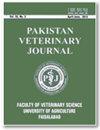求助PDF
{"title":"Nickel Nanoparticles Induced Nephrotoxicity in Rats: Influence of Particle Size","authors":"S. Z. Abdulqadir","doi":"10.29261/pakvetj/2019.106","DOIUrl":null,"url":null,"abstract":"Received: Revised: Accepted: Published online: October 21, 2018 May 28, 2019 August 21, 2019 October 15, 2019 Since nickel compounds are carcinogenic and strong toxicants to the various organs, it is necessary to carry out extra in vivo trials on Nickel nanoparticles (NiNPs) to demonstrate their influences on health pragmatically. The current study was executed to scrutinize the expected undesired impacts of various sizes of NiNPs on renal nephrons of rats. To meet the trial requirements, a total of 24 male Wistar rats, each 12 weeks old were allocated randomly into four groups (n=6). Group 1 was designed as the control (only given sodium chloride 0.9%) while the other three groups (2, 3 and 4) of the experimental animals were exposed to intraperitonial NiNPs (20mg/kg B.W) daily at three sizes (20 nm, 40 nm and 70 nm) for 28 days. Inflammatory cells aggregations of infiltrated leucocytes and degeneration of the proximal tubular cells were the most frequent histopathological features in the NiNPs treated groups which indicates a NiNPs-induced nephrotoxicity. Biochemical analysis of tissue malondialdehyde (MDA), superoxide dismutase (SOD) and serum creatinine were performed. MDA level was significantly elevated (P≤0.05) in all NiNPs treated groups as compared to the control group. All the three NiNPs groups revealed a significant tissue SOD and serum creatinine elevation as compared to the control group (P≤0.05). Furthermore, a significant increase in the p53 positive kidney tubular cells was detected in NiNPs treated groups as compared to control group (P≤0.05). All alterations above in the treated rats were size dependent; the smallest NiNPs being more toxic than the largest ones. ©2019 PVJ. All rights reserved","PeriodicalId":19845,"journal":{"name":"Pakistan Veterinary Journal","volume":" ","pages":""},"PeriodicalIF":3.8000,"publicationDate":"2019-10-01","publicationTypes":"Journal Article","fieldsOfStudy":null,"isOpenAccess":false,"openAccessPdf":"","citationCount":"4","resultStr":null,"platform":"Semanticscholar","paperid":null,"PeriodicalName":"Pakistan Veterinary Journal","FirstCategoryId":"97","ListUrlMain":"https://doi.org/10.29261/pakvetj/2019.106","RegionNum":3,"RegionCategory":"农林科学","ArticlePicture":[],"TitleCN":null,"AbstractTextCN":null,"PMCID":null,"EPubDate":"","PubModel":"","JCR":"Q1","JCRName":"VETERINARY SCIENCES","Score":null,"Total":0}
引用次数: 4
引用
批量引用
镍纳米颗粒对大鼠肾毒性的影响
由于镍化合物具有致癌性和对各器官的强毒性,因此有必要对镍纳米颗粒(NiNPs)进行额外的体内试验,以实际证明其对健康的影响。目前的研究是为了仔细检查不同大小的NiNPs对大鼠肾单位的预期不良影响。为满足试验要求,取24只12周龄雄性Wistar大鼠,随机分为4组(n=6)。第1组为对照组(仅给予0.9%氯化钠),其余3组(2、3、4组)分别以20、40、70 nm 3种不同剂量,每天腹腔内注射NiNPs (20mg/kg B.W),连续28 d。浸润白细胞的炎症细胞聚集和近端肾小管细胞变性是NiNPs治疗组中最常见的组织病理学特征,这表明NiNPs诱导的肾毒性。进行组织丙二醛(MDA)、超氧化物歧化酶(SOD)和血清肌酐的生化分析。与对照组相比,各NiNPs治疗组MDA水平均显著升高(P≤0.05)。与对照组相比,三个NiNPs组的组织SOD和血清肌酐均显著升高(P≤0.05)。此外,与对照组相比,NiNPs处理组p53阳性肾小管细胞显著增加(P≤0.05)。治疗大鼠的上述所有变化都是大小依赖性的;最小的NiNPs比最大的毒性更大。©2019 PVJ。版权所有
本文章由计算机程序翻译,如有差异,请以英文原文为准。


